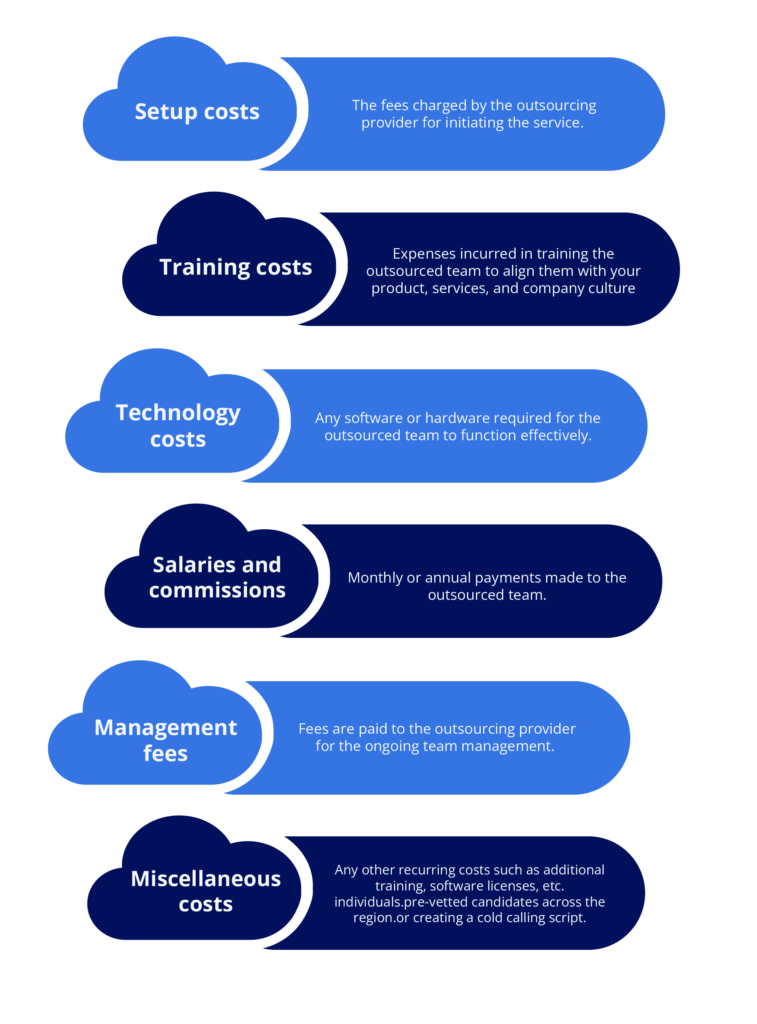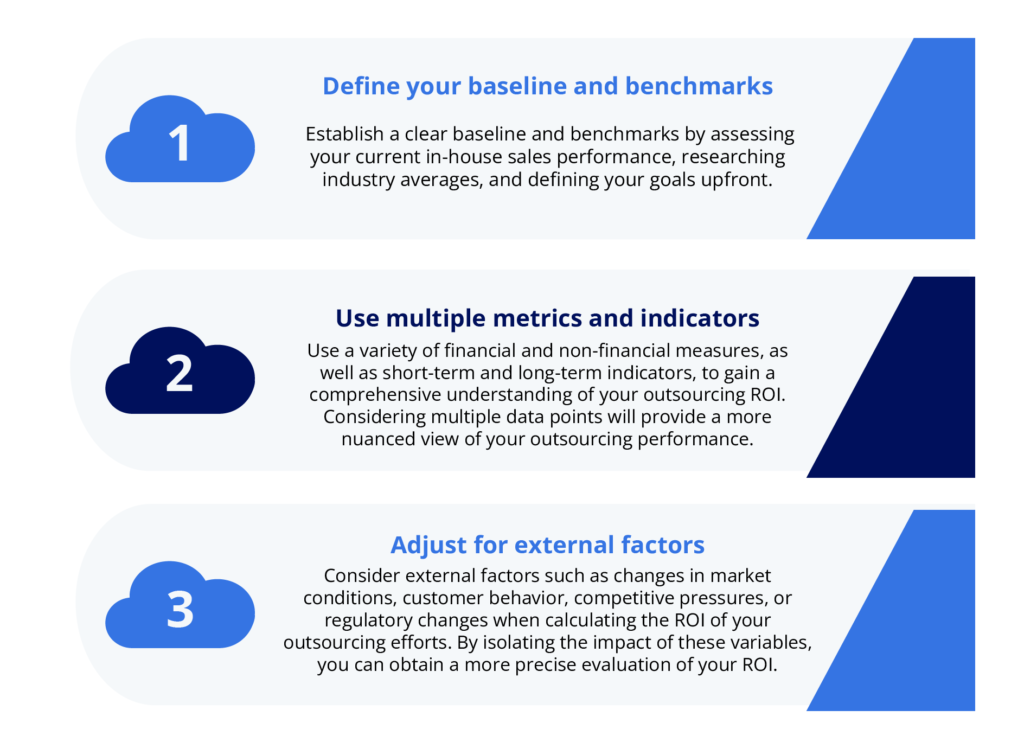Outsourcing sales can be a wise move to boost growth and gain an edge over competitors.
However, it’s not a simple decision.
One of the most important things to consider is the Return on Investment (ROI). Calculating the ROI for your outsourced sales team confirms the financial viability of this strategic choice and aids in ongoing performance evaluation.
This blog post will explain the intricacies of calculating Return on Investment for outsourcing sales and provide a structured approach to making informed decisions.
Understanding ROI in Outsourcing Sales
Return on Investment is an essential metric to consider when outsourcing your sales team. It provides a clear picture of the financial health of your outsourced operations, enabling you to make necessary adjustments.
A positive Return on Investment indicates that your outsourcing strategy favors your business goals, such as market penetration, revenue growth, or customer acquisition.
In contrast, a negative Return on Investment is a warning sign that demands immediate action, such as revising your outsourcing contract or re-evaluating your sales strategies.
Return on Investment is not limited to just financial gains. It is a valuable tool that helps align your outsourced sales activities with your business objectives.
Calculating it also assists in mitigating risks by quantifying the value derived from the outsourced sales team.
If the Return on Investment falls short of expectations, it serves as an early warning system, allowing you to take corrective action before the risks escalate into significant issues.
Components of ROI Calculation
The core components of Return on Investment calculation are the total revenue generated and the investment cost.
Total revenue generated includes direct sales and any upsells, cross-sells, and long-term contracts that can be attributed to the outsourced team.
The cost of investment encompasses all the expenses related to the outsourcing project, such as:

It is essential to clearly understand how costs are distributed and where revenue comes from to calculate ROI accurately.
Revenue can be categorized into two types: direct sales revenue and indirect revenue from upsells, cross-sells, or long-term contracts.
Having a clear breakdown of these revenue sources allows for accurate comparisons when evaluating the effectiveness of your outsourced sales team.
Preparation for ROI Calculation
Preparing for Return on Investment calculation is crucial to ensure accurate and meaningful results.
It involves gathering all the necessary data and identifying the key performance indicators (KPIs) that will be used to measure the success of your outsourced sales team. The preparation phase lays the foundation for a comprehensive and reliable ROI analysis.
To start the preparation phase, you must collect all relevant data, including the sales revenue generated by the outsourced team, the costs associated with the outsourcing project, and any additional metrics that could influence ROI, such as customer lifetime value or churn rate.
It is essential to ensure the accuracy and completeness of this data since it will form the basis of your ROI calculation.
Next, you need to identify the most relevant KPIs to your business goals and objectives.
Some essential KPIs to consider include:
- Cost per lead: This metric measures the average cost of acquiring a new lead. By tracking this KPI, you can assess the efficiency of your lead generation efforts and identify areas for improvement.
- Cost per acquisition: Similar to cost per lead, this KPI measures the average cost of acquiring a new customer. It helps you understand the overall effectiveness of your sales process and can guide decisions about resource allocation and strategy adjustments.
- Average deal size: This KPI represents the average value of a closed deal. Monitoring this metric can help you identify trends in your sales performance and set realistic revenue targets.
- Customer lifetime value: This metric helps estimate the total revenue a customer can generate throughout their relationship with your company. It can guide decisions on customer acquisition and retention.
To ensure you’re fully prepared for ROI calculation, following a pre-calculation checklist is helpful.
This checklist should include the following steps:
- Compile all financial data, including costs and revenue. Ensure you have a complete and accurate picture of the economic aspects of your outsourcing project.
- Identify relevant KPIs that align with your business goals. Choose KPIs that will provide meaningful insights into the performance of your outsourced sales team and help you make data-driven decisions.
- Set a clear time frame for the ROI calculation, such as quarterly or annually. This will help you track progress over time and identify trends in your sales performance.
- Consult with stakeholders from relevant departments to ensure accurate data collection. Involving key stakeholders from sales, marketing, finance, and other relevant departments can help you gather the most accurate and comprehensive data for your ROI calculation.
Calculating Outsourced Sales ROI: A Step-by-Step Guide
For a thorough and accurate analysis of your outsourcing investment, calculating the Return on Investment of your outsourced sales team involves following a series of specific steps.
This step-by-step guide will help you achieve that:
Step 1: Tally Initial Investment Costs
To calculate Return on Investment, you should begin by adding all the costs associated with outsourcing your sales team.
These costs may include setup fees charged by the outsourcing provider, expenses incurred in training the outsourced team, and any technology or software investments required to support the team’s activities.
Considering all relevant expenses is essential to understand your initial investment fully.
Step 2: Calculate Ongoing Operational Costs
After determining your initial investment costs for outsourcing your sales team, the next step is calculating the ongoing operational costs.
These costs generally include salaries, commissions, management fees, and other miscellaneous expenses such as additional training or software licenses.
It’s crucial to factor in all the recurring costs to get an accurate view of the total expense of your outsourcing project.
Step 3: Determine Total Revenue Generated
The third step involves calculating the overall revenue your outsourced sales team generates.
This calculation should consider not just the direct sales revenue but also any indirect revenue resulting from upsells, cross-sells, or long-term contracts that can be traced back to the efforts of the outsourced team.
Consider all revenue streams to view the team’s financial impact comprehensively.
Step 4: Calculate ROI Percentage
With your initial investment costs, ongoing operational costs, and total revenue generated, you’re now ready to calculate the ROI percentage.
The ROI formula is:
ROI = ((Total Revenue Generated – Total Cost of Investment) / Total Cost of Investment) x 100.
Calculate your ROI percentage by inputting your figures into the equation to get a precise measure of the financial return on your outsourcing investment.
Measuring Qualitative ROI
When considering outsourcing, it’s essential to factor in qualitative ROI alongside quantitative ROI.
Qualitative factors such as increased brand awareness, improved market penetration, customer satisfaction, and greater flexibility and scalability can significantly impact your long-term success and growth.
An outsourced sales team can serve as an effective brand ambassador, expand your customer base, provide exceptional customer service, and offer greater flexibility and scalability for your business.
Common Pitfalls in ROI Calculation
While calculating Return on Investment for your outsourced sales team, it’s essential to be aware of common pitfalls that can skew your results and lead to inaccurate conclusions.
Some of these pitfalls include:
- Ignoring hidden costs: Be sure to account for all costs associated with your outsourcing project, including any hidden or indirect expenses that may not be immediately apparent. Failing to consider these costs can result in an inflated ROI figure that doesn’t reflect the true financial impact of your investment.
- Overestimating revenue: Be realistic and conservative when estimating the revenue generated by your outsourced sales team. Overestimating revenue can essentially falsely high ROI, setting unrealistic expectations and potentially leading to poor decision-making.
- Neglecting the time factor: When calculating ROI for outsourcing sales, it’s crucial to consider not only the financial gains but also the time required for implementation, training, and management. Neglecting the time factor can lead to an inaccurate assessment of your investment’s impact.
- Lack of ongoing measurement: ROI calculation should not be a one-time event but a continuous process. Regularly updating your ROI figures allows you to track progress, identify trends, and make data-driven adjustments to your outsourcing strategy. Failing to measure ROI on an ongoing basis can lead to outdated and unreliable information.
- Not differentiating between sales roles: When calculating ROI, it’s crucial to consider the contributions and costs of various sales roles, like SDRs, BDRs, and appointment setters. Each role has distinct KPIs and cost structures that should be factored into your ROI calculation to evaluate your outsourcing investment precisely.
To ensure the accuracy and reliability of your ROI measurement, consider the following best practices:

Outsourcing sales can be a smart move to boost growth and gain a competitive advantage in today’s business world. However, it’s essential to accurately calculate and understand the Return on Investment of your outsourced sales team to ensure success.
By taking into account both quantitative and qualitative factors, following a structured approach to ROI calculation, and avoiding common pitfalls, you can make data-driven decisions that optimize your investment and drive long-term success.
A well-executed ROI calculation provides invaluable insights into the effectiveness of your outsourced sales team, allowing you to adjust and refine your strategy over time.
If you’re ready to take your sales to the next level through outsourcing, CloudTask Marketplace is here to help.
Our platform links you with top-performing sales agencies with proven track records. You get detailed agency profiles, transparent pricing, and a streamlined search process.
Start your journey to outsourcing sales success with CloudTask Marketplace today.








